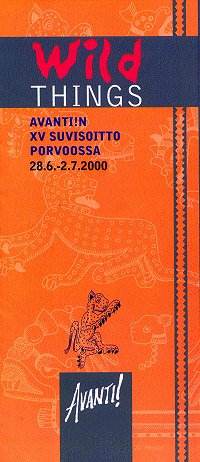
The Avanti! Chamber Orchestra holds its regular summer festival
in Porvoo, a picturesque small town with wood-boarded houses painted in bright
colours, an hour from Helsinki by bus, three by sea. Its tiny Cathedral
[right]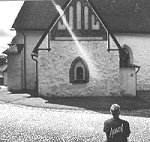 was the site of
the free opening concert, which was to have commenced with a new Fanfare
by Oliver Knussen, guest of honour and featured composer-conductor
for this year's fifteenth Summer Sounds Festival in Porvo, the festival
sub-titled Wild Things as a compliment to Knussen, alluding
to his Sendak opera.
was the site of
the free opening concert, which was to have commenced with a new Fanfare
by Oliver Knussen, guest of honour and featured composer-conductor
for this year's fifteenth Summer Sounds Festival in Porvo, the festival
sub-titled Wild Things as a compliment to Knussen, alluding
to his Sendak opera.
In the event, the only scheduled item to survive to be conducted that morning by Esa-Pekka Sakonen, the festival's artistic director and uncrowned king of Porvoo, was Stravinsky's Symphonies of Wind Instruments, and a fine performance it was, establishing the high standards of this young group, which is more often to be heard touring international festivals than playing at home. The acoustics of the cathedral were ideal, and I cannot recall a more impressive or enjoyable performance of this ever-fresh masterpiece.
The festival's opening had however been beset by problems. Salonen's own new cello concerto had barely been finished in time and, being still with the copyists, had to be moved to the final day. A Fanfare traditionally opens the festival at noon each year. British followers of the contemporary music scene know that Knussen and deadlines do not go well together! Oliver failed to deliver his fanfare, and a last minute local substitute proved less than adequate for so auspicious an occasion.
Far happier was the replacement for Salonen's concerto, Homage to Lorca by Revueltas, a wild thing indeed by that most anarchic and exciting of Mexican composers. It was a huge success with the non-specialist audience, which packed the little cathedral for this half an hour of music, then dispersed for lunch apparently well satisfied. (One odd feature about Finnish musical life, upon which I shall comment again later, is that they seem to be given to very short concerts!)
The day's main orchestral concert of Shostakovich and Mahler was not due until eight and a half hours later. So oppressive was the heat on this hottest of Finnish summer afternoons that walking around to pass the time was out of the question; with no shade to be found, the only escape was to take a river trip!
That evening's concert, attended with due pomp by Finland's new President, Mrs Tarva Halonen, was our first opportunity to enjoy the admirable acoustics of the main festival venue at the Art Factory, a bare-walled, former warehouse complex across the river from Porvoo town, now occupied by artists. The easiest comparison might be with The Maltings at Snape, next to a Suffolk river, as it would have been before being was taken over and rebuilt for the Aldeburgh Festival.
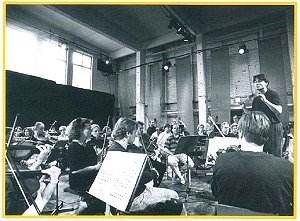
The makeshift auditorium, brought into use for orchestral concerts just once
a year, is a large double cube, with a ribbed roof and bare brick walls,
whitewashed (not too recently) and adorned during the festival with brightly
coloured wall banners, which spelt out the names of all the featured composers.
Never meant for music, it succeeds perfectly, whereas I was told that the
purpose built Finlandia Hall in Helsinki has been equally beset with acoustic
problems as our own Royal Festival Hall!
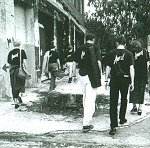
Outside, the muddy parking area into which we were (very slowly) decanted
for the interval was full of puddles to be negotiated (that was our first
experience of a spectacular Nordic summer day which alternated unbearable
heat with several outbreaks of torrential thunder storms, the last synchronised
with the beginning of the adagio of Mahler's 4th
Symphony).
The concert was sold out as soon as announced and the audience numbered about a thousand. It was given by Salonen with an augmented Avanti! orchestra and Victoria Mullova as soloist in Shostakovich's violin concerto No.1. Their careful, well prepared, account of the concerto was a little cool by comparison with the outsize presence of an Oistrakh, but entirely acceptable; very moving in the cumulative build up of the extraordinary lengthy cadenza, in reality a whole movement for the soloist, leading to emotional release with the finale. The balance, without any special effort apparently, was ideal; another example of a composer who knows best, better far than those recording engineers who find it hard to resist making soloists unduly prominent.
Following his exemplary, indeed sober and classical, collaboration with Mullova in Shostakovich, Esa-Pekka Salonen showed a very different side of his conducting persona in the Mahler, 'playing the orchestra' with constant, restless rubato, pointing something in nearly every bar with emphasis on each solo contribution, and relishing Mahler's every special effect. Salonen, still a disarmingly youthful and energetic figure on the rostrum (he soon discarded his jacket!), held the orchestra as in the palm of his hand. It was a virtuosic demonstration of what can be achieved with careful, thorough preparation and, for the most part, thoroughly enjoyable despite lurking doubts. There were some exaggerations which had me wondering what Mahler had prescribed at those points, most strikingly the extreme slowing of the strings and reduction of their tone to an almost inaudible, mere thread of sound before the raucous ending of the second movement, in which the leader Jari Valo had given a particularly effective account of the Devil's music on his specially tuned instrument. Hillevi Martinpelto took us into Mahler's child's vision of heaven very nicely, but I did wonder this time whether that song doesn't have one verse too many, especially as it seemed to get slower and slower, forcing us to make a mad rush through the downpour to catch the last bus back to the City!
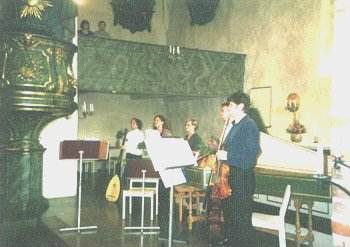
For the final day of Summer Sounds we returned to Porvoo, taking the 3 hour
journey (similar to London/Helsinki by air!) by boat, wending its way through
some of the 30,000 islands of the archipelago. In Porvoo Cathedral
Battalia, Finland's leading early music ensemble (two baroque violins
with gamba, theorbo and harsichord) contributed a suitably wild programme
of some of the 17 & 18 C's more extravagant and picturesque chamber music.
The Sonata La Guerra (cosi nominatat di sua maesta) by Johann
Westoff (1656-1705) of Dresden rang the changes on the possible instrumental
combinations in its ten picturesque movements. Telemann's Gulliver Suite
for two violins alone has a Lilliput Chaconne, a
Brobbingag's gigue and ends with the Fury of the Yahoos! J.
J. Walther's Sonata Imitatione del Cuccu for violin, theorbo and
harpsichord was delicate and very pleasing and a Polish Bagpipe by Schmelzer
for the whole ensemble made a fine rumbustious, rustic finish to the concert.
Most striking of all in this fascinating and well conceived programme was
C. P. E. Bach's remarkable Trio Sonata Sanguinique melancolique in
which the two violinists characterise contrasted moods, the one determinedly
melancholic breaking in to contradict the other's efforts to be jolly, the
two eventually reaching a rapprochement.
The proceedings wound up with a veritable marathon five hour concert at the Art Factory, with three conductors, Miguel Harth-Bedoya, Oliver Knussen and Esa-Pekka Salonen himself, cited as responsible for Artistic Planning of the entire festival. Unfortunately it lacked focus or any thematic coherence, as did the festival as a whole. A selection of novelties was embedded in a conventional symphony concert ending with a typically indulgent, and sometimes untidy, Tchaikovsky's Fourth from Salonen, which did not make for a satisfying end to the entire proceedings, before we braved yet another Finnish drenching outside the Art Factory.
On the way, during a long evening, we heard music by Oliver Knussen and Julian Anderson (his Alhambra Fantasy) representing Britain, and Magnus Lindberg's Grand Duo brought home to Finland. Before the Tchaikovsky there was an arresting and moving song sequence by Jouni Kaipainen, which did not sit well next to Salonen's deconstructive new cello concerto, unveiled for its delayed premiere.
Harth-Bedoya had turned out routine performances of Rossini's
Cinderella overture and Haydn's Symphony No. 85 (with a charming obbligato
tune on mobile phone to bring a smile at just the right point in the slow
movement!). These did not leave one eager to hear again this hyped American
protege of Salonen's but, with Esa Tapani an
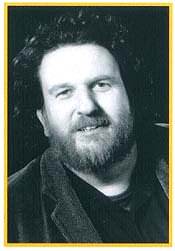 admirable soloist, Oliver Knussen's brief Horn Concerto Op. 28,
("perhaps more concert aria than concerto", as the composer disarmingly
confessed) went far better.
admirable soloist, Oliver Knussen's brief Horn Concerto Op. 28,
("perhaps more concert aria than concerto", as the composer disarmingly
confessed) went far better.
The concerto had been composed immediately after Knussen's Op. 27 of 1997, two little Organa after Perotin, tiny jewels as here subjected to the composer's fastidious supervision of his section of the evening (Knussen had introduced to Porvoo his Op. 20 & 21,Where the Wild Are and The Way to castle Yonder the previous day). Julian Anderson's recent evocation of Spain, his Alhambra Fantasy, in which a trumpet was spotlit, failed to solve the basic problem of the standard London Sinfonietta line up - one should not be left wishing that there were more strings than the usual quintet of soloists.
Lindberg's Grand Duo for a large ensemble of winds, horns and brass to either side of the woods, was quite another matter. Premiered by Rattle in Birmingham earlier this year, it displayed consummate skill in blending all the permutations available in his rich palette, massive sonorities contrasting with small groups and individuals. The programme book, which gives over an inordinate amount of space to full page photos of people in Avanti! tee shirts, had several omissions and was a little hard to navigate; whilst there were notes in English about the British music, there was none to explain Lindberg's title. Always an explorer, Grand Duo was far from the teeming complexity of Lindberg's more familiar scores, and had more in common, perhaps, with the dignity of the Stravinsky Symphonies for Winds heard earlier in the festival. The textures and harmony were purposely non-abrasive and it ended with a solemn sequence of repeated chords, which also brought to mind Beethoven in its satisfying finality. This work should enjoy an enduring concert life and must be as satisfying to play as for listening. It would go well with the Stravinsky and, too, and with another major masterpiece for winds that came to mind, Mozart's Serenade for Thirteen Wind Instruments.
And it was well placed to be followed, after the second interval, by another important Finnish composition, ten years old but new to us. Jouni Kaipainen's Stjarnenatten (Starlit Night) for soprano, cellos & basses, percussion and piano was introduced as 'the most beautiful music' ever written by this composer, now in his mid-forties, and I would not seek to argue. Conceived as a tribute to Dutilleux's La Nuit Etoilée, and playing continuously, the six poems of Sodergran follow the clock from evening to dawn. Hillevi Martinpelto was the ideal interpreter, secure and with her tone always beautiful in the demanding high soprano line, which is supported by the most subtle interplay of ten low strings, punctuated by piano and three discreet percussionists - delicious!
Salonen's new concerto may need some revision. Well received (an element of loyalty maybe?) it made a confusing, muted impression in the 1000-seated Art Factory. Salonen did not plan a conventional concerto confrontation and Anssi Kartutunen, his long time cellist collaborator, was given a part which, whilst visibly exacting, was for long periods nearly absorbed and submerged below a carpet of sound from the rich, dense textures of the fifteen-piece sinfonietta ensemble. Much of it was avowedly romantic, with a high singing cello line, arpeggiated accompaniments and piano arabesques. There were fast, jazzy sections, which found this powerful cellist somehow unable to project, then a solo opportunity for a cadenza which exploited extremes of wildness, and harmonics so high as to become inaudible, with gestural playing very like we are accustomed to on double bass from Barry Guy. Towards the end, the music seemed to become stuck, circling around a sequence of portentous chords on piano and tam-tam, unsure where to go next, before eventually racing to a prestissimo conclusion. Contrary to my habitual stance, this is a piece which may have sounded better on the TV transmission and would benefit from a 10% enhancement of the cello part on the CD which is likely to follow in due course.
Organ recitals
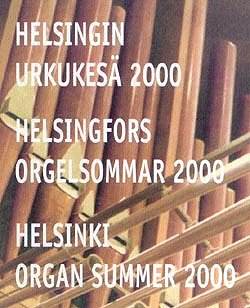
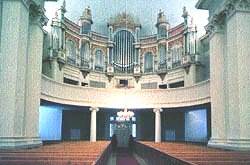
I have mentioned
the Finnish penchant for short concerts. During the summer closed season
in the Capital, we sought out organ recitals, several being advertised under
the rubric Summer Organ. We arrived just too late to catch the end of our
first; the English are not alone in being helpful but prone to offer confusing
or wrong travel directions! Comprising Bach's Prelude BWV 532 and two of
Schumann's Fugen uber B-a-c-h Op. 60, it was all over in twenty minutes,
so we went in as the audience was coming out! We were in good time for our
next organ recital, in the austerely beautiful but unadorned Protestant Cathedral
(for a sumptuous ornate interior one needed to visit the Russian Orthodox
Cathedral nearby). But this was also frustrating, because it consisted of
the Toccata, Adagio and Fugue BWV 564, given as fine a performance
by Seppo Murto on the superb Marcussen organ
[above right] as you are
likely to hear during J.S.Bach's 2000.
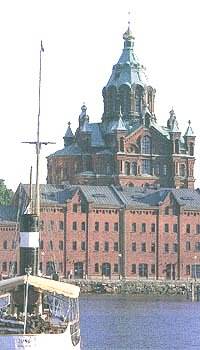 |
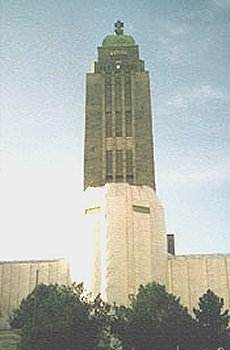 |
Russian Cathedral |
Kallion Church |
But that was all, a quarter of an hour musical oasis punctuated, unhappily, by groups of tourists popping in and out for a couple of minutes, all seeming tone-deaf and oblivious, one not even bothering to remove his Walkman earpiece! The listening audience numbered few, as too did those for Jan Lehtola and Markku Makinen in Kallion Church (shrouded like a Christo sculpture for building works!).
Here we struck gold. No Bach, instead a rare programme of 20th Century music
by organist composers Najim Hakim, Jehan Alain and Gaston Litaise (1909-91).
These young performers, still in their late twenties, had studied together
in Amsterdam and formed a regular organ duo in 1994. They framed their 50
minute evening recital with
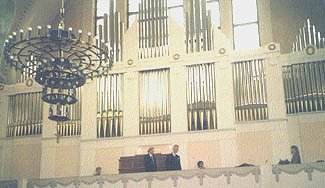 Hakim's Rhapsody for Organ Duet and the Litaise Sonate
a deux pour Orgue a quatre mains. These, I was assured, produced the
most decibels ever heard in the Kallion, but I found it tonally entirely
acceptable.The Hakim, in five movements, was the more original of the duet
pieces, subjecting a variety of traditional sources to clever variations
of registration and harmonic treatment. The Litaise was rather more derivative,
essentially diatonic but encompassing polytonality. For their solos, the
two organists gave respectively another piece by Hakim, Mariales,
and Alain's always welcome Danses a Agni Yavishta which draws on eastern
music. They are shortly going to make a CD of this unusual programme.
Hakim's Rhapsody for Organ Duet and the Litaise Sonate
a deux pour Orgue a quatre mains. These, I was assured, produced the
most decibels ever heard in the Kallion, but I found it tonally entirely
acceptable.The Hakim, in five movements, was the more original of the duet
pieces, subjecting a variety of traditional sources to clever variations
of registration and harmonic treatment. The Litaise was rather more derivative,
essentially diatonic but encompassing polytonality. For their solos, the
two organists gave respectively another piece by Hakim, Mariales,
and Alain's always welcome Danses a Agni Yavishta which draws on eastern
music. They are shortly going to make a CD of this unusual programme.
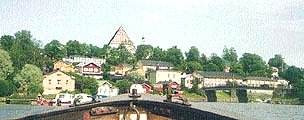
To sum up the whole experience of our first visit to Finland. Porvoo is a
charming and picturesque town, but Summer Sounds there is not a festival
to be recommended to foreign visitors for its music as a main attraction.
It is better to stay in Helsinki which, with competitive air pricing, has become readily affordable as a holiday base, but with so much to see there, you would be unlikely to undertake daily journeys for all the concerts in Porvoo. The capital becomes relatively deserted for the summer holiday season, with the opera house and Finlandia concert hall closed whilst all the residents are in their summer cottages or away abroad.
 A
week in Helsinki passes very pleasurably nonetheless; it is a very attractive
small city, with spectacular vistas and the harbours a source of continual
delight. The streets are paved with granite and the zebra crossings are made
of hard black and white rock. The city centre boasts several exceptional
museums and offers enticing lakeside walks and boat excursions locally, or
further as desired. The famed Finnish flair for design is evident everywhere
and the Helsinki quayside markets are stocked with unaccustomed merchandise,
superb fish, and reindeer, moose and bear meat!
A
week in Helsinki passes very pleasurably nonetheless; it is a very attractive
small city, with spectacular vistas and the harbours a source of continual
delight. The streets are paved with granite and the zebra crossings are made
of hard black and white rock. The city centre boasts several exceptional
museums and offers enticing lakeside walks and boat excursions locally, or
further as desired. The famed Finnish flair for design is evident everywhere
and the Helsinki quayside markets are stocked with unaccustomed merchandise,
superb fish, and reindeer, moose and bear meat!
It was fascinating to discuss and contemplate the lifestyle of people who embrace their summer enthusiastically and enjoy the short -lived luxury of pavement cafe life and boating during its perpetual daylight, before the return to winter darkness when their boats become trapped in frozen rivers and seas.
Yes, take a holiday in Finland and, with the assistance of the ever helpful Tourist Information Office, take in such music as may be found.
Recommended CDs:
Lindberg Aura & Engine BBC Symphony Orchestra/London Sinfonietta/Oliver Knussen DG 463 184-2
Battalia 17th Century Italian & English ensemble music ALBA ABCD 112 & 139
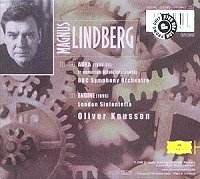 |
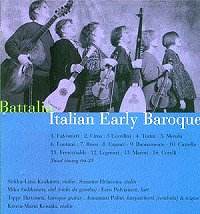 |
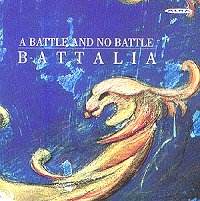 |
Peter Grahame Woolf
 Return to:
Return to: